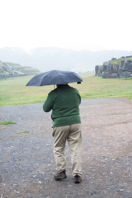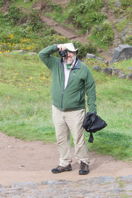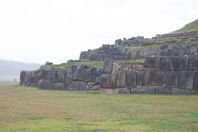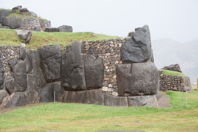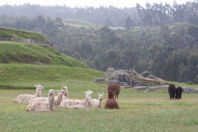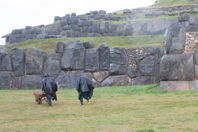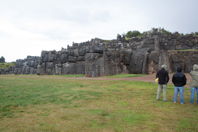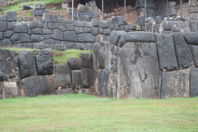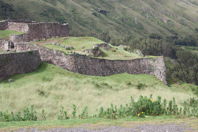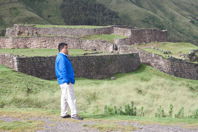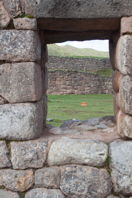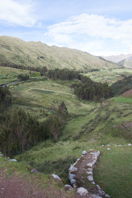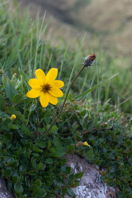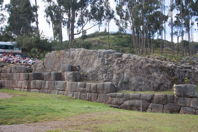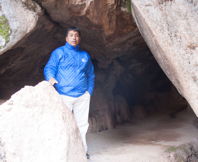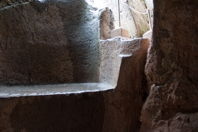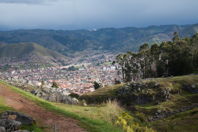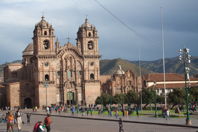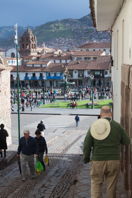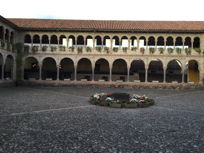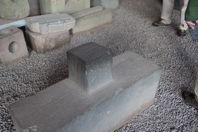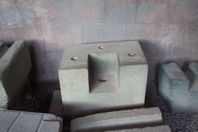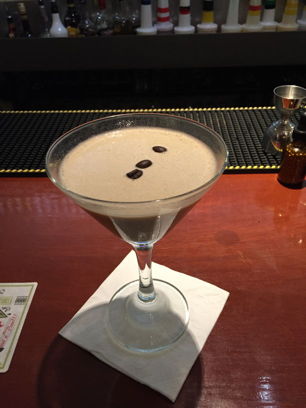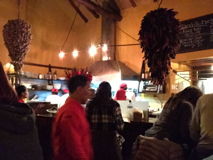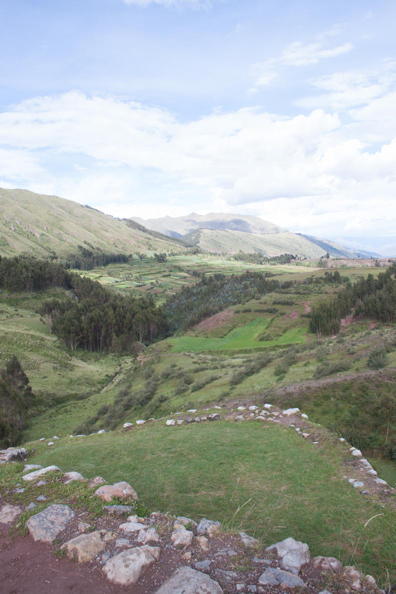
|
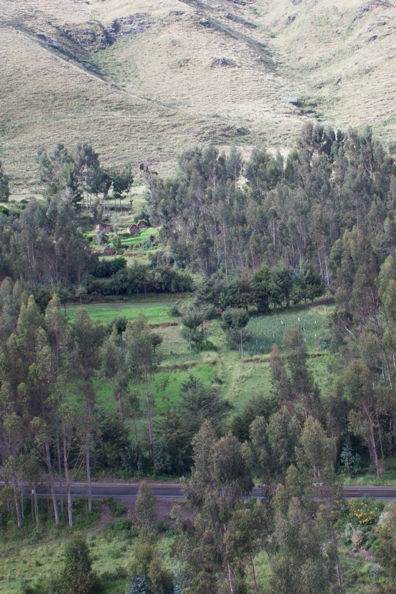
|
| The countryside as viewed from Puka Pukara | |
Monday, April 20, seventh day in Perú
Cusco, Saqsaywaman, and Puka Pukara
Our short stay in Lima included a satisfying breakfast in our hotel. Since we had had no proper supper the night before, we were glad to have such a good meal here. It is a business-people’s place, after all, and it seems that breakfast here is a fairly standardized affair: steam tables with sausage and bacon; potatoes; and eggs, scrambled. Lots of fruit, including that most South American fruit of all, pineapple.
We were picked up at 7:00 by Ulises, and then had a good long wait for our 10:15 flight to Cusco. We were met there by Alexandra, who took us (with driver Romulo) to the Casa Andina Private Collection Cusco. She gave us advice about altitude sickness, which I had been very worried about, and she strongly recommended coca tea, but warned us against having it in the late evening because of its caffeine content. She also warned us against having too heavy a lunch: just a light soup, she said.
We had our lunch in the hotel, rather than going out, and followed Alexandra’s recommendations to the letter. I would say that our only serious trouble with the altitude was that first day, when climbing up one flight of stairs to our room winded us totally.
We were picked up at 2:00 by Romulo, with our guide Rubén, who would be with us for the duration of our visit here in Cusco and Machu Picchu both. This first day, Rubén showed us Saqsaywaman, which was the main ceremonial site and capital of the Inca empire. It’s where you find those amazing giant stones fitted together with no crack in between — you’ve seen the pictures before, and you’re going to see some more here. In a way, the site is just a shadow of its intended self, ’cause the Spaniards took away as many of the stones as they could move, for constructing the City of Cusco down below.
The site is immense and immensely impressive. When we arrived, the rain was falling rather heavily, and we were glad to have our umbrellas. As the day wore on, though, the rain stopped and the sky cleared gratifyingly. The first two pictures to the right give an idea of the construction, though without any human figures, not of the scale. As to the last picture on the right, Rubén told us that llamas are not native to this area, but that they have been imported for keeping the grass down.
The pictures in the second row probably give a better idea of the scale here. When I went through the pictures here at home, I really liked the first picture in the second row,. The raincoat-clad workers look like something out of Bruegel, so covered over by their gear that any hint of their individuality is hidden.
After Saqsaywaman, we went to another site, Puka Pukara, an equally ancient high construction of the Incas, but of uncertain purpose. That the stones were less tightly and precisely fitted may indicate that it didn’t have the importance of Saqsaywaman. But no matter: it wasn’t the architecture here that impressed the two of us most. Rather the breathtaking views of the countryside down below, very beautiful, and reminding me of some of the lovely farmland we saw in Chile.
Puka Pukara is about a thousand feet above Cusco, so really really high. My journal actually spends some time on the question of altitude sickness: «I had definitely felt the effects of the altitude in our first few hours here. A bit of dizziness and light-headedness, and then climbing the stairs to our room in the hotel had brought on a feeling of discomfort, though I wouldn’t say I was panting. When I lay down in the room, I got a bit of a headache, which seemed to dissipate when I stood up and went down for lunch. I can’t say that I felt badly affected in the climbs around Puka Pukara…» I just took things easy and didn’t try to push. By evening, nothing like headache or dizziness, though climbing up the hill that night to the Museo del Pisco and our restaurant did make the both of us huff and puff.
After Puka Pukara, we visited Q’inqu, an Inca holy place with grottos and some serious working of the living rock. I guess it’s not really known what went on there. Some pictures both left and right.
That was it, for ancient monuments up in the mountains. We descended, and my journal says, «From up there, back down to the city and the Plaza de Armas [always the central square in a Latin American city] from which autos are forbidden during the day. I saw an immense church and assumed that it was the Cathedral, but Rubén said, no, that’s the Jesuits’ church. The Cathedral was to the left of that, and seemed a less unified design, and indeed one might say that the Cathedral has three, count’em three, naves. Unfortunately, we could take no photographs: the ornateness of the whole thing will be hard to remember without those records.» All I can remember is that the central nave had a golden altarpiece—stolen from the Incas of course—and would have been where the (European) gentry took Mass; while the nave to the right of that had a silver altarpiece—mined by native slaves of course—and would have been where the (indigenous) plebeians took Mass.
From there, to the Church of Santo Domingo, built on the site of Qurikancha, the main religious site of Inca Cusco. Once again, we could not take pictures inside the church and convent, but we could see and photograph the sections revealed by a relatively recent earthquake. These have the original precisely engineered Inca construction, some stones fitting together with mortise and tenon. The religious facilities themselves were in a sad state, with clear evidence of earthquake damage remaining unrepaired.
By now, we were ready to rest our eyes and maybe have a drink. My journal says, «We walked back to our hotel from Santo Domingo, and fussed around a bit before going out at about six to the Museo del Pisco, a very nice [busy] bistro-tapas bar with a huge drink menu, most of the items involving Pisco. Mark chose a drink that amounted to a Manhattan: Pisco, sweet vermouth, bitters. Mine, a “Pisco Carajo”, was Pisco, Bailey’s, simple syrup, cream, Kahlúa, and a double espresso. All mixed together, with three coffee beans floated on top. It was delicious, even though too sweet by half. I think the cream and the Bailey’s slowed down the absorption of the alcohol, and I was not as tipsy as Mark claimed to be. I should say that someone warned us against alcohol in the first high-altitude two days. Clearly we ignored this.
«From the Museo del Pisco we went a block further uphill, to a second-floor restaurant called Cicciolina. It is interesting that after the uphill climb, that further flight of stairs caused us both to pause to regain our oxygenated equilibrium. The place was busy, and without a reservation we were left with bar seating. We were placed at the usual kind of high table with high stools to sit on; an American couple were seated in a window-seat within reach. Before long, we were chatting, and had good conversation.
«We chose to have nothing but three starters, split between us. Duck carpaccio; “Causa”, which is a construction of mashed potatoes and deboned guinea pig; and seafood skewers. Delicious all around, and we were well sated. Now I can say that I finally have eaten Rodent. We split a special dessert involving custard apple (Annona reticulata) over a torte made of an unspecified Amazonian nut, and dulce de leche ice cream. The totality was very good. We left, and went to bed directly. M was asleep by 2030, and I turned my light out at 2100. Neither of us slept at all well.»
But we would be ready for the next day’s adventure.
| The array of bottles of Pisco at the Museo del (iPhone panorama shot). |

|
